Video of the Week:
When is a Watermelon Ripe on the Vine?
Upcoming Events:
http://hnr.k-state.edu/events/2016%20GG%20Vegetable%20Research%20Tour.pd
Vegetables:
Harvesting Winter Squash
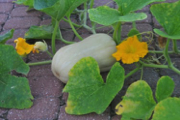
There are two main characteristics that help tell us when winter squash are mature: color and rind toughness. Winter squash change color as they become mature. Butternut changes from light beige to deep tan. Acorn is a deep green color but has a ground spot that changes from yellow to orange when ripe. Gray or orange is the mature color for hubbard.
A hard, tough rind is another characteristic of mature winter squash. This is easily checked by trying to puncture the rind with your thumbnail or fingernail. If it easily penetrates the skin, the squash is not yet mature and will lose water through the skin -- causing the fruit to dry and shrivel. Also, immature fruit will be of low quality. The stem should also be dry enough that excessive water doesn’t drip from the stem.
Winter squash should be stored cool with elevated humidity. Ideal conditions would be 55 to 60 degrees F and 50 to 70 percent relative humidity. Under such conditions, acorn squash will usually last about 5 to 8 weeks, butternuts 2 to 3 months and hubbards 5 to 6 months. (Ward Upham)
Fruit:
Fertilize Strawberries
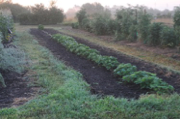
Nitrogen, applied mid August, will help promote fruit bud development. A general application rate is ½ to 3/4 pound of actual nitrogen per 100 feet of row. The nitrogen may be in the form of a fertilizer mixture such as ammonium phosphate or 12-12-12, or in a fertilizer containing only nitrogen such as urea or ammonium nitrate. Some specific examples would include:
Iron + (11-0-0) at 6 pounds per 100 feet of row.
12-12-12 at 5.5 pounds per 100 feet of row.
Nitrate of Soda (16-0-0) at 4 pounds per 100 feet of row
Ammonium sulfate (21-0-0) at 3 pounds per 100 feet of row
Urea (46-0-0) at 1.5 pounds per 100 feet of row
On sandy soils, the rate may be increased by about a half. After spreading the fertilizer, sprinkle the area applying at least a half-inch of water to move the nitrogen into the strawberry root areas. (Ward Upham)
Turfgrass:
Recommended Tall Fescue Cultivars
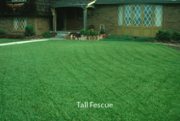
Each year the National Turfgrass Evaluation Trial rates tall fescue varieties for color, greenup, quality and texture. Quality ratings are taken once a month from March through October. The cultivars listed below received an average rating of 6.0 or above when 2013 and 2014 ratings were averaged. Note that K-31 consistently rates at the bottom. The highest rated cultivars were Thor, Michelangelo, GTO, Traverse 2, Technique, Maestro, Firebird 2, 4th Millennium SRP, Reflection, Black Tail, Avenger II, Falcon V, Terrano, Rowdy, Rockwell, Rhambler 2, Hot Rod, Firewall, Bizem, Titanium 2LS, Hemi, Firecracker, Leonardo and Grande 3.
There are a number of other cultivars that did not make this list but should do well in Kansas. Go to http://www.ntep.org/states/ks2/ks2_tf.htm for access to the data. Keep in mind that mixes of several varieties may allow you to take advantage of differing strengths. It is not necessary for mixes to contain only the varieties mentioned above.
Though K-31 may still be a good choice for large, open areas, the new cultivars will give better performance for those who desire a high-quality turf. (Ward Upham)
Kentucky Bluegrass Variety Selection for Cool-Season Lawns
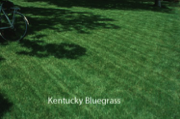
Recommended cultivars for high-quality lawns, where visual appearance is the prime concern, include Alexa II, Aura, Award, Bewitched, Barrister, Belissimo, Beyond, Diva, Everest, Everglade, Excursion, Ginney II, Granite, Impact, Midnight, NuChicago, NuGlade, NuDestiny, Rhapsody, Rhythm, Rugby, Skye, Solar Eclipse, STR 2485, Sudden Impact, Washington and Zifandel. Such lawns should receive 4 to 5 pounds nitrogen per 1,000 square feet per year and would typically be irrigated during dry periods to prevent drought stress. Cultivars that do relatively well under a low-maintenance program with limited watering often differ from those that do well under higher inputs. Good choices for low maintenance include Baron, Baronie, Caliber, Canterbury, Dragon, Eagleton, Envicta, Kenblue, North Star, and South Dakota. Instead of the 4 to 5 pounds of nitrogen per 1,000 square feet per year, low-maintenance program would include 1 to 2 pounds of nitrogen per 1,000 square feet per year. Obviously, a low-input lawn will not be as attractive as a higher-input lawn, but you can expect the cultivars listed above to look fairly good in the spring and fall, while going dormant in the summer. (Ward Upham)
Pests:
Dutch Elm Disease (DED)
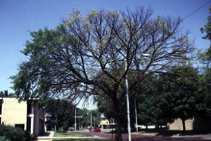
Early diagnosis can help save recently infected trees. Look for branches with leaves that have wilted and suddenly turned yellow to brown. Remove a portion of the branch and peel back an area of the bark. If you notice brown streaking in the sapwood, you may have Dutch elm disease. Healthy bark is more cream-colored and the streaking is absent. Suspect wood should be submitted to the diagnostic lab and control measures started immediately.
Dutch elm disease can often be controlled through the use of systemic fungicide injections, judicious pruning of affected trees and removal of nearby diseased elms. However, trees infected through root grafts with nearby infected elms or those in which the disease has reached the main stem cannot be saved. Therefore, preventative measures have a better chance of success and are preferred. Fungicides labeled for Dutch elm disease include Arbotect and Alamo. The Arbotect fungicide is preferred because it is the most persistent with a three-year interval between injections. A trained arborist should administer injections. These treatments are quite expensive. Check with your local arborist for current prices.
Megan Kennelly, one of our plant pathlogists, has a more detailed discussion of this disease in our Turf Blog. See http://blogs.k-state.edu/turf/dutch-elm-disease/ (Ward Upham)
Pine Tip Moth
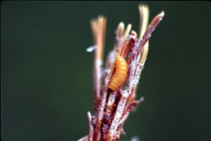
This is a pest primarily of scotch, ponderosa and mugo pines. Thanks to Willy Goevert of 4C Christmastree Farm that does the local pheromone trapping and monitoring of this pest. (Ward Upham)
Contributors: Ward Upham, Extension Associate
 RSS Feed
RSS Feed
